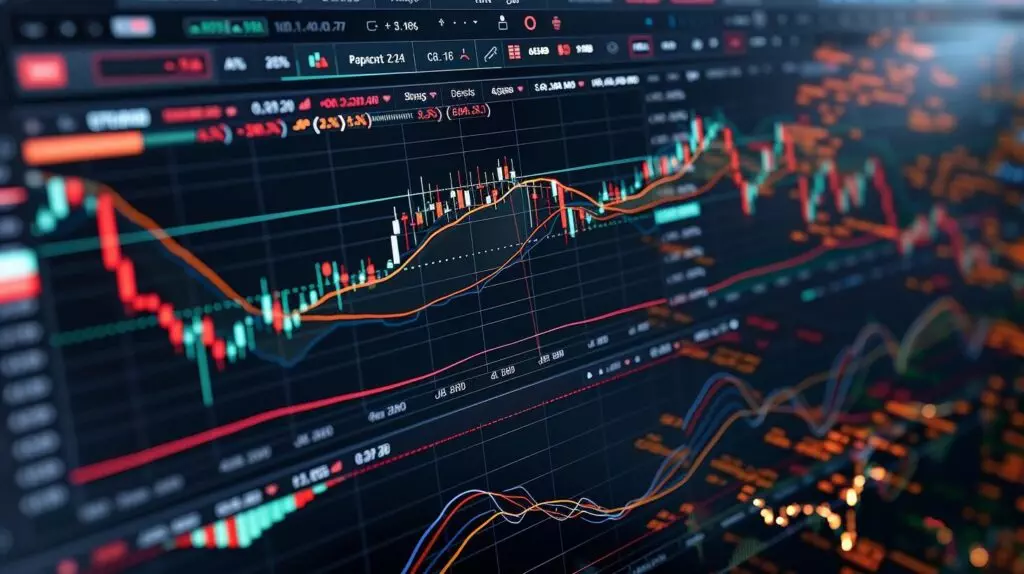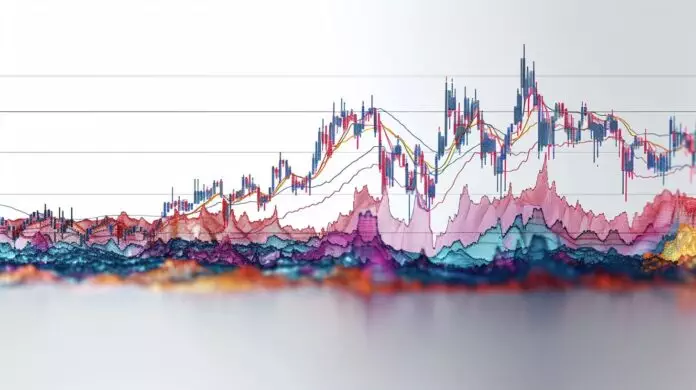The dynamic landscape of day trading necessitates the right moving average not as mere tool, but instead as a guiding system. The decision between options such as the Simple Moving Average (SMA) or the Exponential Moving Average (EMA) could substantially enrich our approach, provided we can pinpoint the one that flawlessly corresponds to our requirements.
Let’s explore how the right moving average can transform our approach to day trading in our Best Moving Average for 5 Min Chart guide.
Key Takeaways
- The 5-8-13 moving averages are highly effective for analyzing 5-min charts in intraday trading.
- Combining moving averages with other indicators offers a comprehensive view for decision-making.
- Experimentation with different moving average periods can lead to optimized trading strategies.
- While moving averages aid in identifying trade points, always consider market trends and diversify indicators for success.
Understanding the Importance of Moving Averages in Day Trading

Moving averages play a vital role in a day trader’s toolkit, helping to pinpoint the right moments to buy or sell. These averages smooth out price data over a specific period, making it easier to identify the direction of the market trend.
Moving averages are particularly indispensable when analyzing a 5-minute chart, providing a clear visual representation of the market’s current momentum, allowing for informed, quick decisions.
One common strategy is the moving average crossover, involving two moving averages of different lengths. A buy signal is initiated when the shorter EMA crosses above the longer SMA, indicating an uptrend or potentially bearish if the opposite occurs. Conversely, a sell signal occurs when the EMA crosses below the SMA, suggesting a downtrend.
Furthermore, the Volume Weighted Moving Average (VWMA) incorporates volume into the average and is a popular moving average. This means that periods with higher volume have a greater impact on the average, providing insights into the strength behind price movements.
Types of Moving Averages Used for Day Trading

In day trading, we commonly rely on several types of moving averages: Simple Moving Averages (SMAs), Exponential Moving Averages (EMAs), and Weighted Moving Averages (WMAs).
- SMAs give a lucid view of the price trend by averaging the closing prices over a definite period. This makes them a popular moving average.
- EMAs give more weight to recent prices, making them extremely valuable in intraday trading. This responsiveness to recent market activity allows us to catch trends early and adjust our strategies swiftly.
- WMAs, by assigning different weights to different price points within the same period, provide a nuanced view of the market.
Best Moving Averages for 5-Min Chart Analysis

The 5-8-13 moving averages have shown remarkable effectiveness for 5-min chart analysis. These periods represent a fine balance, capturing short-term price movements without excessive noise, making them ideal for the fast-paced environment of a 5-min chart.
In a case study, incorporating these moving averages into 5-min chart analysis significantly improved the trading outcomes. Traders were able to identify and act on price movements more effectively, demonstrating the power of these tools in intraday trading.
How to Use Moving Averages as a Technical Analysis Indicator

Let’s dive into how moving averages can serve as both pivotal support and resistance levels in technical analysis. When we’re analyzing the 5-minute chart, moving averages help us identify where the market sentiment might shift. These levels act as invisible barriers where price action tends to bounce or break through, guiding us on when to enter or exit a trade.
Using moving averages as a trigger to enter a trade is another critical aspect. Here’s how we can emotionally connect with this concept:
- Anticipation: The moment when the price action approaches a moving average on a 5-minute chart, our hearts race, anticipating a potential breakout or reversal.
- Decision: Deciding to buy or sell based on the moving average crossover or bounce generates a mix of anxiety and excitement, knowing that this decision could lead to a profitable trade.
- Confirmation. The relief and satisfaction when other day trading strategies and technical analysis indicators confirm the moving average signal, reassuring us that we’ve made the right decision.
Incorporating moving averages with other technical analysis indicators enhances our trading strategy on the 5-minute chart. For instance, combining them with volume indicators or momentum oscillators can provide a more comprehensive view of the market. This approach helps confirm the signals provided by moving averages, increasing our confidence in the trade decisions we make.
Can Using Relative Volume Indicators Help Enhance Trades with Moving Averages on a 5 Minute Chart?
Using efficient relative volume indicators can greatly enhance trades with moving averages on a 5-minute chart. By analyzing the volume in relation to price movement, traders can better identify potential entry and exit points. This added insight can lead to more informed and successful trading decisions.
Advanced Tips for Day Traders Using Moving Averages

While moving averages are powerful, they are not standalone indicators. Smoothed moving averages and the golden cross work best when combined with an understanding of overall market trends in day trading strategies. Consider the bigger picture and align your entry and exit points with the broader market trends.
Avoid over-dependence on moving averages because they reflect past prices and can sometimes produce false signals. Relying solely on them without considering other factors like volume and price action can lead to missed opportunities or misinterpretation of market signals.
Here are some advanced tips:
- Coordinate the use of moving averages with additional indicators such as the RSI, MACD or bollinger bands.
- Experiment with different periods for your moving averages.
- Always examine the wider market sentiment and economic indicators while using the moving average in your decision-making process.
- Look for visual patterns on the chart that confirm the signals.
- Use moving averages to set stop-loss orders intelligently.
Conclusion
We’ve explored the essential role moving averages play in day trading, especially on the 5-minute chart. We’ve examined how different types of moving averages add depth to our trading strategies, striving to identify the most effective ones for efficient analysis.
By applying these averages as a key technical indicator, and incorporating our advanced tips, we’re better equipped to make informed decisions, boosting our trade performance.
It’s clear that mastering moving averages is a game-changer for any day trader’s toolkit.
Frequently Asked Questions
What are the best moving averages for day trading on a 5-minute chart?
The most commonly used moving averages for day trading on a 5-minute chart are the 5-period exponential moving average (EMA), the 8-period EMA, and the 13-period EMA.
How do I determine the moving average period to use for intraday trading?
The choice of moving average period for intraday trading depends on your trading strategy and the level of sensitivity you require. Traders often use the 5-8-13 combination, which provides a good balance between responsiveness and smoothness.
Can you provide a case study illustrating the use of moving averages for day trading on a 5-minute chart?
Certainly, day trading strategies involving moving averages can change the game! In a case study analyzing stock prices on a 5-minute chart, the 5-8-13 moving averages were used to identify bullish chart patterns and trends, leading to successful trade entries and exits.
What are SMAs and how are they relevant to using moving averages for day trading?
SMAs, or simple moving averages, are basic arithmetic means of a set of data points. For day trading, SMAs are commonly used to identify trend reversals and to improve the timing of trade entries and exits.
How can I identify the best moving average to use for my 5-minute chart analysis?
Choosing the best moving average involves considering factors such as the degree of responsiveness, the sensitivity to market volatility, and the compatibility with your trading strategy. Trial various moving averages like 13-bar simple moving averages, observe their impact and optimize the parameters for better trading decisions.



